September 9, 2019
Design thinking — which encourages a focus on users and rapid experimentation — can help identify and address a range of problems by focusing on those most affected by the problem. Originally designed for a business context, what might a design thinking process look like in a school district, where local politics, established policies and well-intentioned bureaucracy can stifle even the best ideas?
We sought to find out. Education First spent the last two years working and learning alongside Dallas Independent School District (DISD), Austin Independent School District (AISD) and Tulsa Public Schools (TPS) as part of the How I Know: Designing Meaningful Formative Assessment Practice project supported by the Michael & Susan Dell Foundation. Our role was to help these three districts apply design thinking principles to help teachers improve their formative assessment practice. We knew from our own research that formative assessment practice is critical to effective teaching and learning. But as is typical in any structural change, there are significant barriers to effective implementation.
The challenge for the field and for our project was this: Knowing that teachers face a range of competing priorities for their time and that traditional approaches to professional development often do not result in sustained changes in classroom practice, how might we systematically support teachers to implement more consistent and effective formative assessment practice?
To answer this question, the Dell Foundation provided funding for a two-year pilot program that would support twenty teachers in each district to experiment with new formative assessment practices using a design thinking model. Over the course of the two years, Education First worked with district design teams to understand and build a process to oversee and support pilot teachers and campuses using a Design Thinking Roadmap we customized for this project from design thinking resources.
The teams experienced many successes. Pilot teachers who took advantage of the opportunity and support to try new practices in their classroom saw for themselves the impact on students. Students increasingly took ownership of their learning and engaged with more rigorous content, and teachers grew more comfortable with releasing control over that learning to their students. In all three districts, increased attention to formative assessment practices in classrooms encouraged cultural and mindset shifts to greater transparency, collaboration and shared learning which in turn changed the kinds of lessons teachers designed and the way they taught. Teachers also benefited from job-embedded professional learning and peer-to-peer learning, that gave them a clear vision of the transformative possibilities of formative assessment practice within the context of their own student community, the opportunity to try out new practices with support and a collaborative school-based community for shared accountability.
The overlay of a design thinking framework on traditional district professional learning structures and practices also presented design teams and technical assistance providers with distinct challenges. While there is no one-size-fits-all solution because each district faces its own unique set of circumstances and constraints, district and school leaders and design teams should consider how they will adapt their design process to work around these challenges:
- Providing the opportunity for rapid cycle testing: District procurement processes can be a hindrance to rapid cycle testing. For example, to bring in a professional development partner may require the approval of the school board, a process that can take several months and require detailed plans that leave little room for the kind of rapid cycle testing of various solutions to user experiences that design thinking calls for. Traditional professional development contracts can lock a vendor into place, leaving the district with less flexibility to change course in mid-contract if the problem changes or solution needs to be adapted.
- Engaging users as a regular part of data analysis and project design: Design thinking places a premium on understanding the user experience and creating space for users to participate in the design of the systems that most affect them. Most teachers teach by themselves all day, limiting their ability to collaborate with other teachers or respond to ongoing requests for feedback or to attend design meetings. School and district leaders also face numerous demands on their time and there are limits on when, how often, and for how long you can bring teachers and administrators together within and beyond the school day.
- Creating a safe space for the messiness of learning and “fast failing”: At the heart of design thinking is the need for space to try and fail. This approach can be in direct conflict with structures like teacher evaluation, where teachers’ opportunities for advancement and salary raises depend on adhering to and complying with observation rubrics that may not incorporate formative assessment practices. Power dynamics between principals and teachers may also inhibit candor and the giving and receiving of effective feedback as teachers try new formative assessment practices. If principals do not understand what to look for or what the teacher is trying to do, teachers can be penalized. In a school culture focused narrowly on strict curriculum implementation or where principals don’t nurture innovation, teachers may also be unwilling to experiment with new instructional practices.
Design thinking processes pose strong challenges to traditional district, school and classroom structures and behaviors. But we think the strong focus on user (teacher) experience and providing teachers with the time and space to try new things and fail (and learn) dovetails nicely with formative assessment’s focus on peer feedback and student ownership of their learning. As we worked with district design teams to apply a design thinking framework to formative assessment practice, we learned several important lessons about how to use design thinking to solve district-wide problems. We offer these recommendations to districts considering adopting this design framework:
- Confirm whether design thinking is the right framework to solve your problem. The problems most ripe for this framework are those that are complex: for which the problem itself is not clear, and the solution is not straightforward. For example, our project’s formative assessment focus asked teachers to change their behavior and their mindset, which is an adaptive challenge rather than a technical one. We wanted to provide teachers with time to experiment in their classrooms to see how they could adapt their teaching to encourage more student ownership of the learning process. In adapting a design thinking framework for district change, district and school leaders need to be honest and transparent about what is realistic in terms of possible solutions and who will ultimately decide what solutions to move forward.
- Build a truly inclusive design team, prioritizing users most affected by the problem and ensuring they are able to contribute meaningfully to the design process. By the end of the second year of the project, all district teams committed to including teachers and principals on their design teams and engaging them in meaningful ways but this was not initially the case. Our three districts operated in very different contexts with varying approaches to teacher and principal engagement. Across the board, districts did not involve principals early enough and substantively enough in the work to enable them to support the teachers in the pilot. Teachers also were not regularly included in design team discussions for reasons discussed above. As discussions on monthly calls continued, and particularly as observation data started to come in on teacher formative assessment practice, design teams realized they needed to better understand what was happening in these classrooms. At least two of the districts conducted empathy interviews with teachers and principals to learn more about their experiences with formative assessment and one district set up quarterly teacher listening sessions for design team members to meet with pilot teachers and learn more about their experiences.
- Spend time to truly understand the problem to be solved by design thinking. This phase can span weeks or even months as the team iterates on the problem, collects and analyzes data, and revises the problem again. The goal is to know the problem inside and out so that any solutions directly address it. In applying for their grants from the Michael and Susan Dell Foundation, the three districts had already decided that formative assessment was the solution to the problem of supporting students to succeed by improving teacher practice. At the same time, we asked district design teams to engage in root cause analyses during their implementation planning to clarify how formative assessment would address those root causes. Our districts dug into these discussions but there are so many competing priorities and time is at such a premium that it was difficult for district design teams not to jump to solutions to get the work going.
- Build out prototypes for the specific problem(s) you’ve identified and test them with rigor before taking anything to scale. The value of design thinking comes in the slowing down, taking time to design small tests of potential solutions that are directly related to the problems that surface during the “define” stage. Working in a district context created a constant tension between slowing down and testing, and rushing to scale as a way to ensure the longevity of the work. Our primary question at the end of the second year was, “what exactly are you going to scale?” All three districts have decided to expand the number of teachers and schools receiving coaching and professional learning in formative assessment although none of the three are scaling district-wide.
- Use the Design Thinking Roadmap as the foundation for design team meetings. This tool, which we developed after the first year of the project, can serve as a helpful reminder of what a design thinking process looks like and help design teams reflect on where they are and what they need to do to move the work forward to the next step.
As pilot participants in Dallas, Austin and Tulsa would tell you: it’s worth staying the course. In our final project convening, pilot teachers reported that they were excited about the ways formative assessment gave them a new sense of ownership over their teaching and a new relationship to their students. Principals reported how exciting it was to see their teachers grow and the connections to student agency and ownership. District design team members noted the strong connections between design thinking and equity and were excited by how formative assessment seemed to be transforming teacher practice. It’s been and continues to be a productive challenge. To learn more about this project, please see the How I Know website or reach out to Education First.


